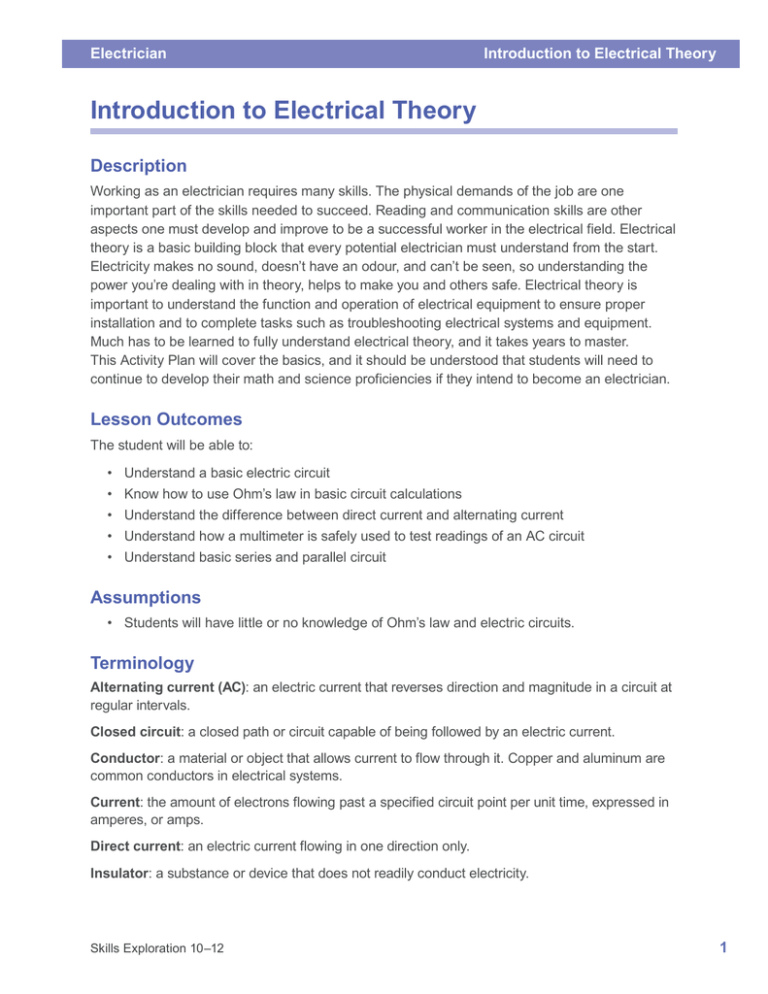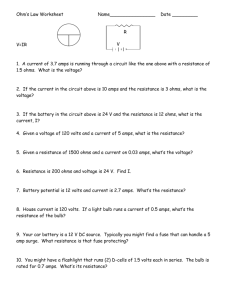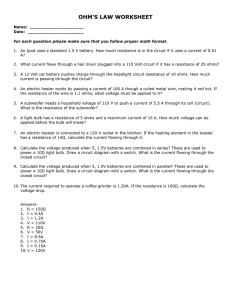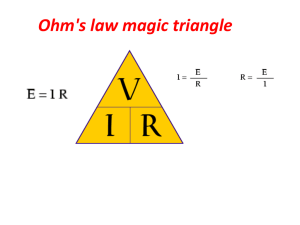Introduction to Electrical Theory
advertisement

Electrician Introduction to Electrical Theory Introduction to Electrical Theory Description Working as an electrician requires many skills. The physical demands of the job are one important part of the skills needed to succeed. Reading and communication skills are other aspects one must develop and improve to be a successful worker in the electrical field. Electrical theory is a basic building block that every potential electrician must understand from the start. Electricity makes no sound, doesn’t have an odour, and can’t be seen, so understanding the power you’re dealing with in theory, helps to make you and others safe. Electrical theory is important to understand the function and operation of electrical equipment to ensure proper installation and to complete tasks such as troubleshooting electrical systems and equipment. Much has to be learned to fully understand electrical theory, and it takes years to master. This Activity Plan will cover the basics, and it should be understood that students will need to continue to develop their math and science proficiencies if they intend to become an electrician. Lesson Outcomes The student will be able to: • Understand a basic electric circuit • Know how to use Ohm’s law in basic circuit calculations • Understand the difference between direct current and alternating current • Understand how a multimeter is safely used to test readings of an AC circuit • Understand basic series and parallel circuit Assumptions • Students will have little or no knowledge of Ohm’s law and electric circuits. Terminology Alternating current (AC): an electric current that reverses direction and magnitude in a circuit at regular intervals. Closed circuit: a closed path or circuit capable of being followed by an electric current. Conductor: a material or object that allows current to flow through it. Copper and aluminum are common conductors in electrical systems. Current: the amount of electrons flowing past a specified circuit point per unit time, expressed in amperes, or amps. Direct current: an electric current flowing in one direction only. Insulator: a substance or device that does not readily conduct electricity. Skills Exploration 10–12 1 Introduction to Electrical Theory Electrician Multimeter: an electrical test instrument that can measure several values, usually voltage, current, and resistance. Ohm’s law: a law in electricity that states that the current (amps expressed as I) in a circuit is proportional to the potential difference (voltage, expressed as E) divided by the resistance of the E E circuit (ohms, expressed as R), I = or E = I×R or R = R I Open circuit: an open path preventing the flow of current. Parallel circuit: electrical components or circuits connected to common points at each end, rather than one to another in sequence. More than one path for current to flow. Resistance: the opposition of a body or substance to current passing through it, resulting in a change of electrical energy into another form of energy commonly heat or light. Series circuit: electrical circuits or components arranged so that the current passes through each successively. One path for current flow. Short circuit: a path of low resistance allowing a high current to flow. Voltage: electromotive force or potential difference, expressed in voltage or volts. Electrical pressure. Watt: the SI unit of power, equivalent to 1 joule per second, corresponding to the power in an electric circuit in which the potential difference is 1 volt and the current 1 ampere. Power formula, P (watts) = E ×I or P = I2 ×R Estimated Time 2–3 hours Recommended Number of Students 20, based on BC Technology Educators’ Best Practice Guide Small groups of 2–4 based on equipment available Facilities Technology education shop with benches Tools • AC circuit • teacher demonstration: – multimeter – scientific calculator 2 Skills Exploration 10–12 Electrician Introduction to Electrical Theory Materials • Battery holders (2) • 1.5-volt batteries (2) • 3-volt light boards or connecting wires • Light bulbs • Alligator clips Optional Scientific calculators Resources Basic Theory & Ohm’s Law http://www.youtube.com/watch?v=b3XS4lAxvrc An Analogy for Ohm’s Law http://www.allaboutcircuits.com/vol_1/chpt_2/2.html Sample Curriculum: Current Electricity http://www.mst.edu/~pringle/Phys302/Handouts/current.pdf How to Draw Simple Electric Circuits Lesson http://www.youtube.com/watch?v=52JoONLGl2s Skills Exploration 10–12 3 Introduction to Electrical Theory Electrician ©WorkSafeBC. Used with permission from the publication ”Working Safely Around Electricity.” 4 Skills Exploration 10–12 Electrician Introduction to Electrical Theory Activity: Current Electricity Experiment How this activity is sequenced is to be determined by the teacher. There are some resources to help explain Ohm’s law, and the teacher might want to start with a small “theory of Ohm’s law” lesson, or complete the lesson after the activity. The depth of this activity is based on students’ prior level of knowledge. Students will do a review of a few simple DC circuits that likely will have been covered in Science 9. These experiments should help students understand how resistive sources react when placed in series and parallel circuits. Optional Activity If DC circuit materials are not readily available, the teacher may show the Basic Theory & Ohm’s Law video (see the Resources section) to refresh students’ knowledge of a basic electric circuit and Ohm’s law. The video could also supplement the DC circuit activity. The “Analogy for Ohm’s law” link (see the Resources section) could also be useful to help explain Ohm’s law to students having difficulty understanding the concept. The worksheet provided will allow students to practise calculating basic Ohm’s law problems. Evaluation Guidelines The student: • Works safely • Follows instructions • Demonstrates knowledge and understanding • Answers questions correctly Skills Exploration 10–12 5 Introduction to Electrical Theory Electrician Ohm’s Law Problems Show your work. 1. 3 volts is applied across a 6-ohm resistor. What is the current flowing? 2. A 1.2-ohm resistor passes a current of 0.2 amps. What is the voltage across it? 3. What is the voltage of a circuit with a resistance of 250 ohms and a current of 0.95 amps? 4. A small electrical pump is labelled with a rating of 3 amps and a resistance of 40 ohms. At what voltage is it designed to operate? 6 Skills Exploration 10–12 Electrician Introduction to Electrical Theory 5. A 9-volt battery is hooked up to a light bulb with a rating of 3 ohms. How much current passes through the light? 6. A lamp is plugged into the wall outlet, which is providing 110 volts. An ammeter attached to the lamp shows 2 amps flowing through the circuit. How many ohms of resistance is the lamp providing? 7. If your skin has a resistance of 10,000 ohms and you touch a 9-volt battery, what current will flow through you? 8. What current will flow through your body with a skin resistance of 10,000 ohms, if you touch 120-volt house potential? Skills Exploration 10–12 7 Introduction to Electrical Theory Electrician 9. When you are soaked in seawater, your resistance is lowered to 1000 ohms. Now how much current will flow through you if you touch the 9-volt battery? 10. When you are soaked in seawater, what current will flow through you if you touch the 120volt house potential? 11. How much current flowing through your body is considered fatal? 8 Skills Exploration 10–12 Electrician Introduction to Electrical Theory Answers 1. 3 volts is applied across a 6-ohm resistor. What is the current flowing? E = IR E = 3 volts I= ? R= 6Ω E I= R 3 I= 6 I = 0.5 A 2. A 1.2-ohm resistor passes a current of 0.2 amps. What is the voltage across it? E = IR E= ? I = 0.2 R = 1.2 Ω E = IR E = 0.2×1.2 E = 0.24 E = 0.24 V 3. What is the voltage of a circuit with a resistance of 250 ohms and a current of 0.95 amps? E = IR E= ? I = 0.95 R = 250 Ω E = IR E = 0.95×250 E = 237.5 V Skills Exploration 10–12 9 Introduction to Electrical Theory Electrician 4. A small electrical pump is labelled with a rating of 3 amps and a resistance of 40 ohms. At what voltage is it designed to operate? E = IR E= ? I= 3 R = 40 Ω E = IR E = 3× 40 E = 120 V 5. A 9-volt battery is hooked up to a light bulb with a rating of 3 ohms. How much current passes through the light? E = IR E= 9I =? R= 3 Ω I= I= I R 9 3 I= 3 A 6. A lamp is plugged into the wall outlet, which is providing 110 volts. An ammeter attached to the lamp shows 2 amps flowing through the circuit. How many ohms of resistance is the lamp providing? E = IR E = 110 I= 2 R= ? E R= I R = 110 2 R = 55 Ω 10 Skills Exploration 10–12 Electrician Introduction to Electrical Theory 7. If your skin has a resistance of 10,000 ohms and you touch a 9-volt battery, what current will flow through you? E = IR E= 9I =? R = 10,000 E I= R 9 I= 10,000 I = 0.0009 A 8. What current will flow through your body with a skin resistance of 10,000 ohms, if you touch 120-volt house potential? E = IR E = 120 I= ? R = 10,000 E I= R I= 120 10,000 I = 0.12 A 9. When you are soaked in seawater, your resistance is lowered to 1000 ohms. Now how much current will flow through you if you touch the 9-volt battery? E = IR E= 9I =? R = 1000 E I= R 9 I= 1000 I = 0.009 A Skills Exploration 10–12 11 Introduction to Electrical Theory Electrician 10. When you are soaked in seawater, what current will flow through you if you touch the 120-volt house potential? E = IR E = 120 I= ? R = 1000 E I= R I = 120 1000 I = 0.12 A 11. How much current flowing through your body is considered fatal? 0.05 A, or 50 mA 12 Skills Exploration 10–12







